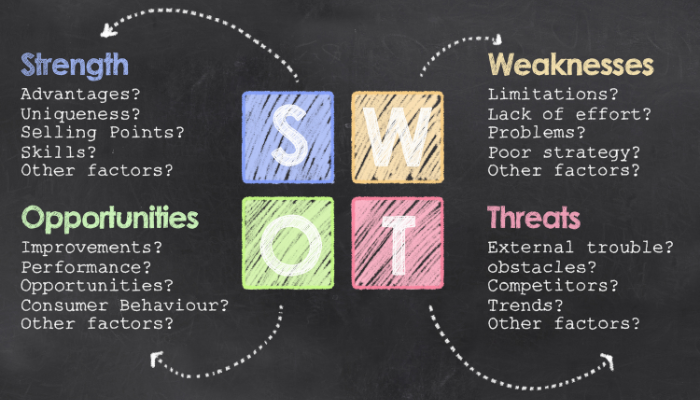A SWOT analysis evaluates the strengths, weaknesses, opportunities, and threats facing your business. This can help you determine where you are strong and where you are weak, which external factors could help or hurt your company's success, and what areas of your business may require more attention to grow. It's an important tool to analyze your security firm and determine ways to improve it moving forward.
What is a SWOT Analysis?
- SWOT stands for strengths, weaknesses, opportunities, and threats.
- A SWOT analysis is a way to list the advantages and disadvantages your firm may face in its business environment.
- This can help you strategically position yourself as you develop your physical security business.
First, write down your strengths and weaknesses. These are internal factors that affect how you conduct business. Weaknesses could be lacking an online presence or not having enough cash reserves to cover unexpected expenses.

Next, you'll write down your opportunities and threats. These are both external factors that impact your business's performance. An opportunity might be expanding into new markets. A threat could include a competitor who provides more affordable services.  Let’s break down each aspect of a well-rounded SWOT analysis and how each relates to areas of your business.
Let’s break down each aspect of a well-rounded SWOT analysis and how each relates to areas of your business.
Internal Strengths
Strengths in a SWOT analysis are a company's favorable internal activities, processes, and behaviors (what a company does well). These are the factors that contribute to the success of the company and its brand.
Examples of Internal Strengths:
Your security firm is strong in the following areas:
- Knowledge of the market, including competitors and customers.
- Ability to find new solutions for common problems, such as new technologies or services that could be useful for your clients.
- Strong public relations efforts, meaning you have good relationships with other businesses and individuals in your industry. They are willing to trust you because they know that you will do what it takes to protect them from threats.
Weaknesses
Weaknesses are internal factors that are holding a company back. They can be due to the company's culture, lack of resources, or lack of management processes. Identifying weaknesses is essential to any SWOT analysis because it allows you to identify areas where you'll need to improve to grow your business and secure new clients.
Here are some examples of common weaknesses:
- The security firm doesn't have enough capital to purchase new technology or equipment or hire additional staff members.
- The security firm has not hired any employees with specific skills (for example, a technology specialist) in recent years and now finds itself lacking technical expertise compared to other firms in their industry.
- The client base for this particular security firm is primarily composed of small-business owners who value personal relationships over price.
External Opportunities
Opportunities and threats are external—things going outside your company, in the larger market. Opportunities are openings for something positive to happen. They usually arise from situations outside your organization and require an eye to what might happen in the future. You can take advantage of opportunities and protect against threats, but you can't change them.
Some examples of opportunities you might encounter:
- Market to businesses. Your security firm should have a solid understanding of the industry and make sure that it stays up-to-date on the latest trends and events. You can then use this knowledge to help you identify possible external opportunities. For example, suppose you know your clients are looking for more comprehensive security services, such as armed physical security and fire safety. In that case, you can position yourself as an expert by providing them with relevant educational information or hiring new employees trained in these areas.
- Market to government agencies. Government agencies have strict regulations regarding protecting their assets; therefore, they will require additional expertise from individuals or firms who specialize in these services before selecting which one(s) will best meet their needs (e.g., law enforcement). If this sounds like something worth pursuing your business, consider contacting local police departments, state parks, military bases, public schools/colleges/universities, etc. - just remember that there are plenty out there, so don't worry too much about competition.
- Market towards schools & universities: Another great way of generating leads is through marketing campaigns aimed at schools & universities because they offer another target audience besides businesses (which might already be covered by competitors). Schools & universities often need physical security during events or even around-the-clock coverage.
 Threats
Threats
Threats are the weaknesses of your security firm. Threats occur when a competitor can identify and exploit a weakness to gain an advantage over you in the marketplace.
Threats can be identified through research, such as analyzing your competitors' strengths and weaknesses, or by looking for clues in the industry, such as trends in private security that could affect your business model. For example, suppose a security breakdown occurs at a live event, causing significant delays in safely getting patrons into the venue. In that case, you have an opportunity to market to the event producer.
Once you've identified these threats, several steps can be taken to overcome them:
- Address any issues that could expose your firm to a threat and fix them immediately, or better yet, prevent them from occurring. If there is no way for you to overcome the threat on your own, consider partnering with another security firm that can help address these issues.
- Invest in technology that will help mitigate these threats, such as video surveillance or artificial intelligence technologies. Look for opportunities to partner with other security firms to help address any issues you may have in technology. It can turn into a mutually beneficial relationship.
There are several ways to identify potential threats:
- Find out what your competitors are doing and how they're responding to these threats. If a competitor has successfully overcome one of their weaknesses, learn from them so that you don't make the same mistakes.
- Look for opportunities in the news that may negatively affect your security firm, such as new legislation being passed or increased cybercrime rates.
Analyzing Competitors in the Physical Security Industry
Once you have identified your competitors, it’s time to dig in and see what they are up to. Find out who they are. Check their websites, look at their social media profiles and search for them on LinkedIn. You can also use tools like Google Alerts or BuzzSumo to track what’s being said about them online.
Next, you want to identify what they are doing well. Look at their marketing and branding. What kind of content are they publishing? How do they interact with their audience on social media? How effective is their website? These things can be done quickly by visiting the company’s website. Finally, find out what they are doing wrong. See if there is any negative press about them or poor reviews on Yelp or Google.
Wrapping Up
A SWOT analysis can be a powerful tool for your business. It helps you to identify areas where your security firm is strong and weak and where opportunities or threats may lie in the future. By performing this type of analysis regularly, you are more likely to keep up with changes in the industry—and be able to prepare for them.



